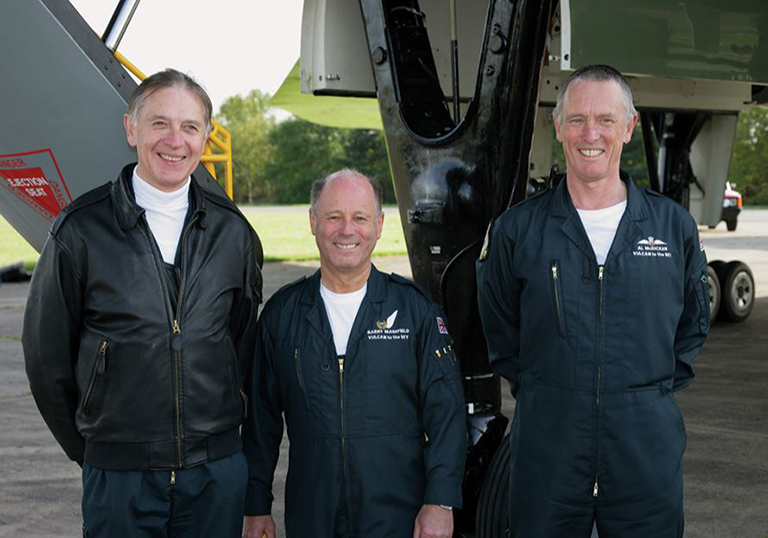
Ramblings from the AEO’s Panel – Part 12
Every year at Wellesbourne Mountford Airfield near Stratford on Avon the XM655 MaPS (Maintenance and Preservation Society) team of Vulcan enthusiasts who look after Vulcan
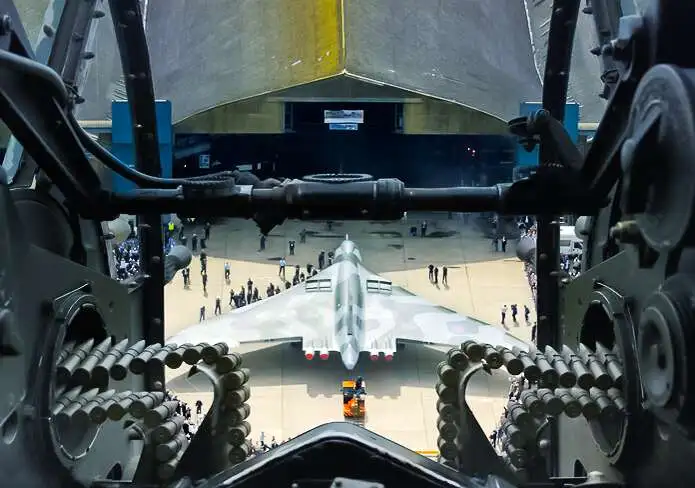
A fresh appeal was launched in March 2004 to reach the Trust’s commitment of 29% of the funding total, required before the HLF would issue a ‘Stage 2 Pass’ and release the grant. Finally, Dr Pleming and Felicity Irwin were able to announce that “this is indeed history in the making. Although we have thought that this day would come it seems to have taken forever and it is hard to really believe that at last we can commence the work on XH558 to return her to her rightful place in the sky. Emotions are running high but we will soon come back to earth and begin the very serious work of recreating an airworthy Vulcan.”
In early 2005, Andrew Edmondson decided to rejoin the Vulcan to the Sky team as Engineering Manager after a 3-year absence in more conventional employment. Andrew’s contribution to defining, planning and directing the technical activities in a unique environment proved vital to success. On the 28th April 2005 the Trust and Marshall Aerospace (as the Engineering Authority) signed the contract that formalised the start of work. The Trust had purchased XH558 from the Waltons, and the Bruntingthorpe hangar underwent the work necessary to gain E4 (design) and M5 (maintenance) approvals from the CAA. Several months later, thanks to a dedicated team of staff and volunteers, the hangar was audited by the CAA and declared ‘fit for purpose’.
In November 2002 the bid for Lottery money was turned down. A shocked Dr Pleming said: “We are aghast at the decision. We are not just enthusiastic about this amazing aircraft, we are professionals that recognise her engineering and heritage value”. Supporters protested, and eventually the VTST was invited to re-apply, with guidance offered on improving the bid by stressing the Vulcan’s role in the Cold War, (a subject that formed part of the state schools’ history curriculum), and emphasising the Vulcan’s excellence as a piece of engineering, at the forefront of aircraft design in its time.
2003 was a nail-biting year as the VTST refined the bid and made a second application, until in December a ‘Stage One Pass’ was announced, with a grant of £2.7million for XH558’s restoration. The HLF’s Chair, Liz Forgan, said: “In the normal way of things we do not restore aircraft to flight but the HLF was really impressed with the imaginative way in which the Trust’s new proposal will let as many people as possible learn about this important part of their heritage.” Sir Michael Knight thanked the Heritage Lottery Fund for “their vision in seeing the significance of the restoration to flight of the last remaining Vulcan and the telling of the Cold War story. ‘Victory for Vulcan’ is so apt as the V-force played such a vital part in the Cold War, which was a global influence from 1945 until 1991. We are delighted and as custodians of this awesome part of British Heritage we feel the responsibility of our role. Thank you to everyone who has played a part in this project and has made today possible.”
Work now began in earnest on the restoration, which it was anticipated would take at least a year. The schedule of tasks included not only the ‘Major’ service, but also rectification work as required, and a modification of the rear spar to extend fatigue life (Mod 2222). In addition, a lot of non- essential equipment was to be removed, including two radar systems, bomb bay fuel tank, electronic countermeasures and a substantial amount of electrical wiring. NDT examination of critical parts of the airframe would also be undertaken, using x-ray, ultrasound and eddy current to detect any cracks or weaknesses in the metal. Inaccessible areas of the airframe would be examined using Olympus videoscope equipment, representing a considerable time and cost saving as the inspections would otherwise require skin removal. The videoscope would also prove invaluable for checking engine internals.
Five Marshall Aerospace technicians would be supported by up to 10 Vulcan to the Sky engineers, and a further 10 logistics and administration staff and some subcontractors. In addition, up to 20 design engineers at the Marshall Aerospace Design Office in Cambridge would be involved. In total, the project would need over 100,000 manhours of effort. The VTST engineers all received a 13 week intensive training programme from Marshalls Aerospace in Vulcan avionics/electrical, airframe and propulsion, providing them with wide ranging skills based on solid understanding of all the aircraft systems. Many of the engineering team were also ex Vulcan or V-Force groundcrew, ensuring an excellent skills base to begin with. Volunteers would also be of immense help, even though due to the training requirements they would not be able to work on the airframe itself.
The restoration to flight was not just about hardware though, the aircraft would need a crew to operate her. The Trust had been loaned the nose section of XM602 by the Avro Heritage Centre at Woodford (the Vulcan’s birthplace), which enabled the flight crew to practice procedure checks. Further invaluable help came from the operators of XM655 at Wellesbourne, who allowed the Trust’s air and ground crew to train on their aircraft. It would therefore be possible to run through engine start and stop procedures, emergency drills and other training requirements on a live Vulcan.
The Inspection phase had identified around 3,000 individual repair tasks, including the deletion of 47 systems and over 20,000 metres of rewiring. For rectification purposes the Vulcan airframe is split into six systems – hydraulic, pneumatic, oxygen, flying controls, fuel and electrical. Physically, the largest of these is the fuel system, with a total of 14 pressurised bag tanks (5 in each wing and 4 in the fuselage), holding a maximum of 74,000lb (9,200 gallons) of fuel. Any cracked or damaged skins in the tank bays would have to be replaced to avoid any risk of puncturing the bags.
The structures bay in the hangar became a hive of activity, with repair and rectification of tank bay skins and a multitude of others. Particular attention was paid to the titanium sheets in the jet pipe tunnels. The heat generated by the jet pipes when in operation would be extreme, so it was vital the sheeting that would protect the airframe from the high temperatures was undamaged.
A particularly unpleasant skin repair was needed in the bomb aimer’s blister, where the aluminium was badly exfoliated and corroded. The blister was where any spilt liquids (and bodily fluids!) tended to gather, causing both corrosion and a nasty smell.
Work had also started on the wing spar modification at the shackle joint. The outer wing of the Vulcan is held to the fuselage at the rear spar by a figure-of-eight shackle plate, fixed by two bolts. As each wing is held by only eight bolts, the removal of two could result in movement of the wing, so supports were put in place to take the strain off the remaining six. The shackle plate and bolts could then be removed to get at the strengthening bars beneath.
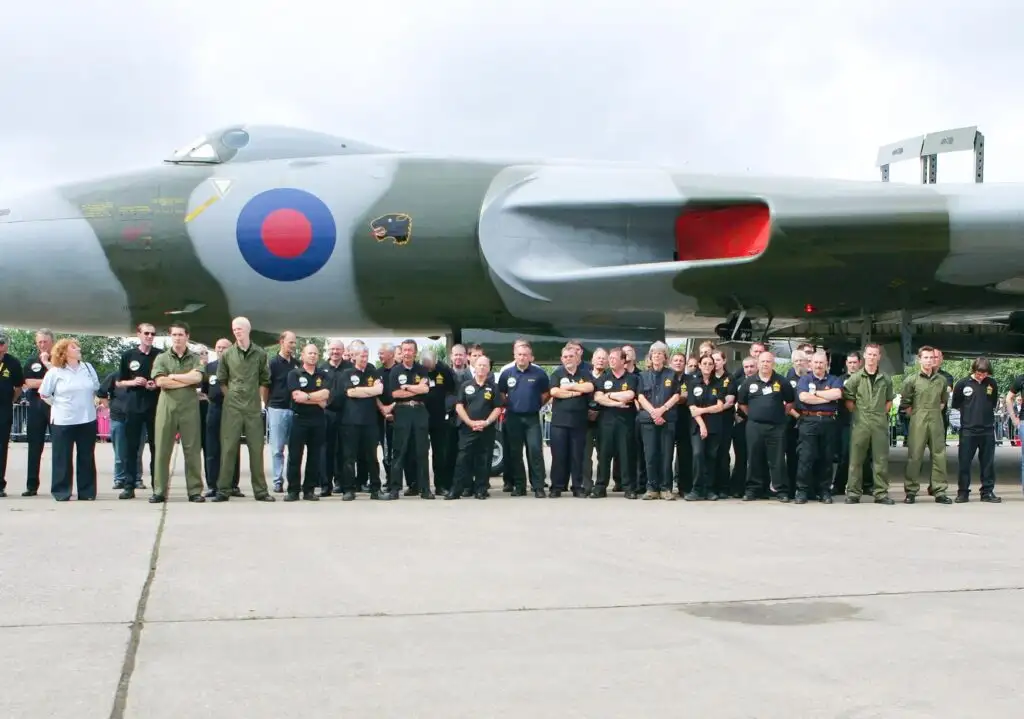
By May 2006 , with rectification work continuing, the recovery phase was underway. Economic resources were being stretched to breaking point though, with cost increases and less than anticipated commercial sponsorship. A review of costs and liabilities in July left the Trustees no option; on 1st August the full-time staff were placed on a month’s notice, and a figure in excess of £1.2 million was needed to avoid closure of the project. It had been planned to roll-out the aircraft at the end of the month (to show supporters and media the progress made), and preparations continued for this, even though there was a very real possibility it could mark the end of the restoration attempt. Skins in the fuel tank and engine bays were refitted, not just for looks but also because there was the possibility of structural movement when the aircraft came off jacks. For aesthetics the fin cap was returned to its place on the tail, and the H2S scanner was refitted in the nose to adjust the centre of gravity.
Despite the short time available, the Trust, with the drive, energy and enthusiasm of XH558’s supporters in the Vulcan to the Sky Club, galvanised media coverage, and the response to it was dramatic. Donations and pledges poured in, and in just 21 days the total was achieved, with a magnificent donation of £500,000 coming from British philanthropist Sir Jack Hayward.
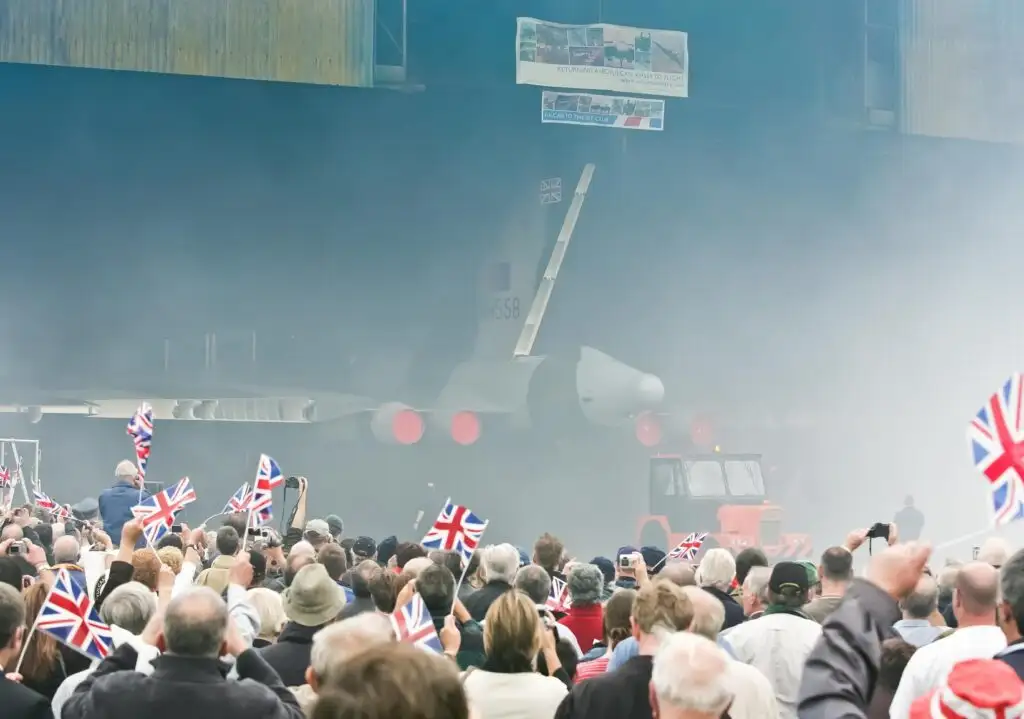
On 31st August 2006, XH558 rolled out of the hangar for the first time in 7 years. In front of an admiring crowd of several thousand supporters the hangar doors opened just before 2pm, and the Vulcan slowly emerged from a cloud of simulated smoke. As she drew to a halt the sound of four Rolls- Royce Merlin engines heralded the arrival of the BBMF Lancaster, making several emotional flypasts in salute. Trust Chairman Sir Michael Knight thanked all those who had made the occasion possible and announced that for the staff, while this was their last day of work, it was also to be their first! Tribute also came from the office of the Prince of Wales conveying Charles’ warmest good wishes: “His Royal Highness has fond recollections of his flight in Vulcan XL392 at RAF Waddington, and was thrilled to hear that XH558 is to be rolled out of its hangar.” Paying tribute to the Club, pilot David Thomas said: “I’m not going to call them club members anymore, I’m going to call them all friends, because they’ve all contributed a fantastic amount of money.” Dr Pleming added: “It confirms what we’d always believed, that this is a People’s Aeroplane, and there are so many people out there who want it to fly.”

Every year at Wellesbourne Mountford Airfield near Stratford on Avon the XM655 MaPS (Maintenance and Preservation Society) team of Vulcan enthusiasts who look after Vulcan
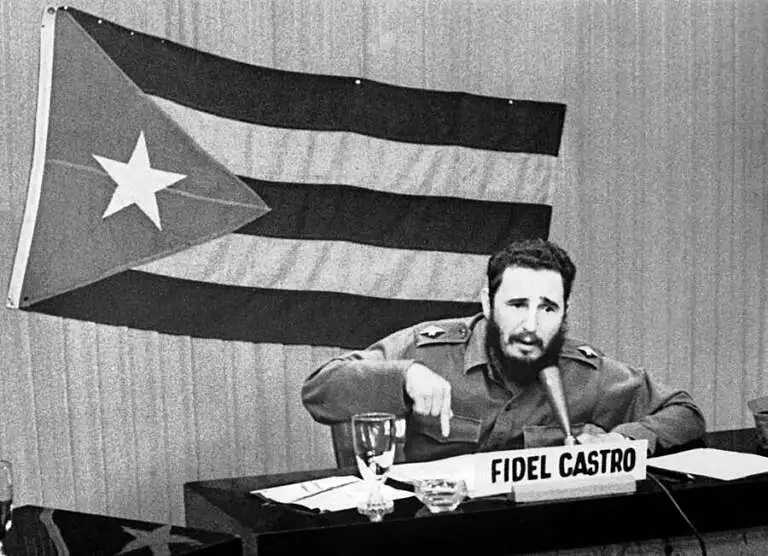
From February 1962 onwards two jets in every major RAF base, armed with nuclear weapons, were on standby for Quick Reaction Alert (QRA). QRA is

Don’t Mess With The Gods We’re continually paying homage to Vulcan, the Roman god of fire and rightly so. Vulcan has played a significant role

Barry Masefield was the Air Electronics Officer (AEO) for Vulcan XH558 and had flown in this iconic aircraft for over 30 years, also being a key